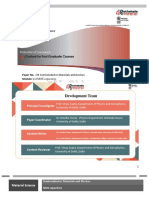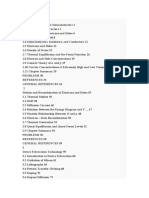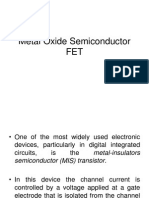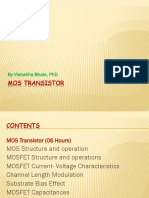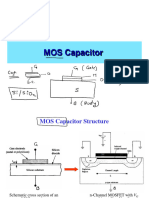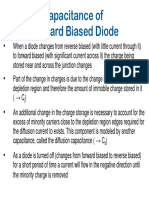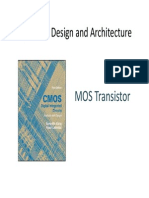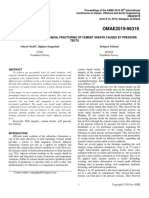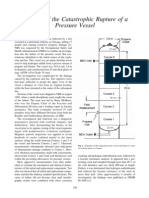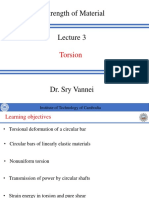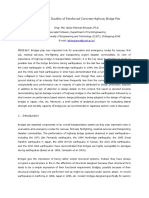Physics of Metal-Oxide-Semiconductor (MOS) Structures (Part I)
Thomas Schrder
IHP - Microelectronics Im Technologiepark 25 15236 Frankfurt (Oder) Germany
IHP Im Technologiepark 25 15236 Frankfurt (Oder) Germany www.ihp-microelectronics.com 2005 - All rights reserved
�Overview
1) MOS structures in important semiconductor device classes
2) Physics of MOS - Structures
IHP Im Technologiepark 25 15236 Frankfurt (Oder) Germany
www.ihp-microelectronics.com
2005 - All rights reserved
�Overview of MOS structures in important device applications
Logic devices: Metal - Oxide Semiconductor Field Effect Transistor
Besides isolation (see image) of the individual transistors from each other, thermally grown silicon dioxide (SiO2) plays a crucial role in the performance of the transistor as the gate dielectric layer. transistor physics and the role of dielectrics will be discussed in the lectures held on 12/2/ 2005
IHP Im Technologiepark 25 15236 Frankfurt (Oder) Germany
www.ihp-microelectronics.com
2005 - All rights reserved
�Overview of MOS structures in important device applications
Volatile Memory devices: Dynamic random access memory (DRAM)
Yesterday: planar cells Today: 3D cells Dielectrics play a crucial role to guarantee the storage of sufficient charge despite continuously shrinking device dimensions
Q s = CSVCC = A i VCC d
Volatile memories and the role of dielectrics will be discussed in the lectures held on 12 / 9 / 2005
IHP Im Technologiepark 25 15236 Frankfurt (Oder) Germany
www.ihp-microelectronics.com
2005 - All rights reserved
�Overview of MOS structures in important device applications
Nonvolatile Memory devices: Flotox and Flash Concepts
Today`s market leader:
Charge is injected (write) and driven out (erase) by high voltage pulses
VT = Q S / CCG
Nonvolatile memories and the role of dielectrics will be discussed in the lectures held on 12 / 16 / 2005
IHP Im Technologiepark 25 15236 Frankfurt (Oder) Germany
www.ihp-microelectronics.com
2005 - All rights reserved
�Overview of MOS structures in important device applications
Nonvolatile Memory devices: Ferroelectric random access memory (Fe-RAM)
Today and more to come in future:
Ferroelectrics allow to store information when the power is switched off
Volatile memories and the role of dielectrics will be discussed in the lectures held on 12 / 16 / 2005
IHP Im Technologiepark 25 15236 Frankfurt (Oder) Germany
www.ihp-microelectronics.com
2005 - All rights reserved
�Overview of MOS strucures in important device applications Scaling makes the development of advanced dielectric layers a hot topic in materials research
Ongoing scaling requires to thin out the dielectric layer Dielectric layers need to meet very different requirements specific for each application
Standard CMOS Important Vital Important Important Important Important Negligible Negligible Nonvoltatile Memories flash FLOTOX Important Important Important Important Vital Important Negligible Negligible -Negligible Negligible Important Vital -Negligible Negligible DRAM Storage Negligible Negligible Negligible Vital Important -Important Important
REQUIREMENTS Electrically Stable Interface with Few Defect Charges High Mobility for High Speed High Reliability against Hot Carriers
injected from substrate
Low Leakage & Few Dielectrics Breakdowns High Reliability against Carriers
flowing through films (high QBD, etc.)
Thermal & Chemical Stability high temp. (850-1000 C) Good Coverage on Steps High Dielectric Constant
Gate Dielectrics in Active FET's
used as Passive Elements
IHP Im Technologiepark 25 15236 Frankfurt (Oder) Germany
www.ihp-microelectronics.com
2005 - All rights reserved
�Overview
1) MOS structures in important semiconductor device classes
2) Physics of MOS - Structures
IHP Im Technologiepark 25 15236 Frankfurt (Oder) Germany
www.ihp-microelectronics.com
2005 - All rights reserved
�Ideal MOS - Structure
Very simple system geometry .. but quite complicate physics
Ideal MOS structure drawn for p-type Si
Let`s start with some idealizations: Thermal voltage: kt/q 1) Work function difference is zero Fermi Potential
F = t In( N D / ni )
ms m ( x + Eg / 2q + F ) = 0
for n-type
www.ihp-microelectronics.com
F = t In( N A / ni )
for p-type
2) No charged defects in the insulator
IHP Im Technologiepark 25 15236 Frankfurt (Oder) Germany
3) No current over the dielectric (perfect insulator)
2005 - All rights reserved
�Ideal MOS Structure at different biases VG
If you bias the metal gate at different gate voltages VG, three different situations can in principle arise: (discussion is based here on p-type Si) Accumulation; majority carriers accumulate in semiconductor surface region
Depletion; negative charge appears in semiconductor surface region because majority carriers are chased away (uncompensated acceptor atoms rest behind) and minority carriers are attracted Inversion; high negative charge is induced in semiconductor surface region more minority than majority carriers (Ei crosses over EF in surface region (intrinsic condition) )
IHP Im Technologiepark 25 15236 Frankfurt (Oder) Germany www.ihp-microelectronics.com 2005 - All rights reserved
�Derive a relationship between the charge in the semiconductor and the surface band bending
Band bending
Fermi Potential
Note: Arrow downwards (upwards): positive (negative) band bending Band bending: zero inside the semiconductor; Surface potential: referenced to Fermi potential
Surface Potential
Result: Band bending is the sum of surface plus Fermi potential
Using the band bending (or surface potential) as a function of the distance x from the interface, the charge carrier concentration can be described as a function of x:
p(x)=N A e / t =n i e / t
IHP Im Technologiepark 25 15236 Frankfurt (Oder) Germany
n(x) = N D e
www.ihp-microelectronics.com
/ t
=n i e
/ t
intrinsic carrier concentration For specific doping level NA and ND
2005 - All rights reserved
�Derive a relationship between the charge in the semiconductor and the surface band bending
From these relations, the 1 D Poisson equation is solved under the following assumptions: 1) NA is uniform over x ; 2) Boltzmann statistics; 3) no surface charge quantization
2 (x) q ==- [ p(x)-n(x)+N D -N A ] 2 x s s
1 D Poisson equation: non-uniform volume charge density causes curvature of potential First Integration: Electric field is given by potential gradient
t = 2 F( ,N A) x LD
s t LD = qN A
2
Debye Length
F( ,N A )= e
- /t
+ /t -1+(n i /N A ) (e
/ t
- /t -1)
just for completeness
IHP Im Technologiepark 25 15236 Frankfurt (Oder) Germany
www.ihp-microelectronics.com
2005 - All rights reserved
�Derive a relationship between the charge in the semiconductor and the surface band bending
The relationship between the charge in the semiconductor surface and the surface band bending then reads:
s t Qs - s s = m 2 F(s ,N A ) LD
Influences of doping concentration: 1) certainly, Fermi level is a function of doping 2) the more p-type the wafer, the higher the potential for inversion Accumulation: From the sign of surface band bending: semiconductor charge is positive Depletion: From the sign of surface band bending: semiconductor charge is negative Inversion: From the sign of surface band bending: semiconductor charge is negative
Solid Line: NA = 4*1015 cm-3 ; Dotted Line: NA = 2*1017 cm-3
IHP Im Technologiepark 25 15236 Frankfurt (Oder) Germany
(a) L = 100 nm Transistor; (b) L = 10 nm Transistor: dielectrics has to survive higher electric fields
2005 - All rights reserved
www.ihp-microelectronics.com






